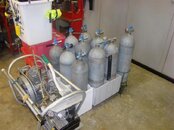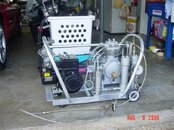OK Guys, I was afraid of this!!! I will try to answer questions, but I just don't have a whole lot of time to go through individual questions when MUCH of this is what I cover in my training courses (I just got back from one, and have to leave Saturday for another!).
Richard,
The important question, to me, is how can old LP 72 cylinders which lack a REE number stamped on the head be tested to and receive a '+' rating?
... If, OTOH, it is more likely a mistake, I need to know about it so I don't overfill the cylinder.
Unlike many, I do NOT want to overfill my cylinders. But if the '+' is correct, I wouldn't mind moving from 2250 to 2475 psi because that is the only way to actually get 72 cf in the tank.
Richard
Ahhhh... reason and logic, I love it! You are absolutely correct in your thinking.
The "+" marking for 110% fill is valid. So, the question is how did the retester do it? 49 CFR 180.215(b)(2) specifies that the test report must include the method by which the average or maximum wall stress was computed. Ask your retester to provide that information. He better have it, since it is a federal requirement. You say later that you don't know who it was. There is a RIN number stamped between the month and year of the requal. It goes in a clockwise fashion, so for A123, "A1" would be over "32" (notice the "23" is reversed). You can look it up on the DOT website or you can email me and I'll tell you who it was.
Mattboy,
Or, more directly, is a hydro tester breaking regulations if he stamps the plus based only on the permanent expansion?
That is correct, he is not following the reg's if he doesn't check the wall stress, and record how he did it.
It sounds like there is a published table (CG-5, whatever that is) that allows the hydro tester to calculate REE. Why couldn't I simply tell the hydro tester in my area to use this table to calculate REE for my tank and give the plus rating.
CGA pamphlet C-5 does give REE numbers for common industrial gas and medical gas cyl's. REE's for SCUBAS are not listed. However, the calculations are there in an easier format than the CFR - there is even an example of how to do the calc's. (Keep reading, I'm going to get you guys the REE's.)
A couple more quick questions for Darrell. One, have you ever seen a 3AA scuba tank that passed hydro fail a plus rating?
Yes, failing hydro means you exceeded 10% permanent expansion, which means the cylinder yielded (like bending the paperclip). Exceeding the REE means you have lost some wall thickness, which does not mean the cylinder will fail hydro. So, you would no longer get the plus rating, but the cyl could remain in service so long as it did not exceed 10% permanent expansion.
Two, the hydro guy in my area stamped the words "no plus" on my tank because he could not find the REE number. This annoyed me because I feel he should have simply stamped the date on his ID, and had no right to add his commentary about my tank due to his inability to administer the plus rating.
You are absolutely correct. That is unauthorized marking (see 180.213), he had no business putting that on the cyl.
You're welcome, but your previous comments (post #13, second half) SCARE ME!!! Your suspicions are wrong!! All cylinders are built to a specific wall thickness (called Tmin) based on their specification and service pressure. While it is true that mfg's overshoot the minimum to make sure any deviations keep within tolerance, you cannot simply say that it's OK to fill to higher pressures. You have convinced your LDS to violate federal regulations. Yes, that cylinder would pass a test at 4000, but if you are still "comfortable" filling to 3000 all day long, you need to go back and read my previous post.
SparticleBrane... you REALLY scare me!!
On the other hand, this kind of overfilling has been going on for decades in certain parts of the country, and I can't honestly say I know of any case of an exploding cylinder due to overfilling in cave country (doesn't mean there haven't been -- just saying I haven't heard of any). If there have been, they are few and far between -- LP (2400+) cylinders are regularly filled to 3600+ day after day, week after week, but they aren't exploding in some kind of tank epidemic. Many of these cylinders are well into multiple hydro cycles. Just saying...

Each year we have incidents on fill lines. Every year or two a fill operator is killed or maimed, or both. The statement is generally, "Gee, THAT never happened before!" It only takes one to ruin your whole day (spelled L-I-F-E). Apparently you weren't listening, or didn't understand what I was saying about cycle life and fatigue failure. Most incidents can be tracked back to not following the regulations.
Ironically enough, I have heard of PST HP (3500psi) and exemption (3442psi) cylinders having issues passing hydro, but their LP cylinders that are consistently overfilled don't seem to have issues with passing.
As I mentioned before, hydro isn't likely to pick up a fatigue issue. Fatigue failure is sudden and catastrophic. Just ask someone who has experienced it... Oh, I guess you can't, most of them are dead. WD8CDH nailed this one. If you have a cylinder that was put through the 90% "pre-test" and it still failed hydro, it is either a BAD cylinder, or a leak (generally at the test connection). [Scared Silly: I will address your post in a separate reply.]
On a slightly different note -- the life of a cylinder just sitting around at service pressure shouldn't have it's life reduced since this is lower than the fatigue range, correct? I have two 119s, a set of double 72s, and an Al80 just sitting around all at service pressure. I would much rather have them like this and be ready to dive, than have to run to the shop and get fills on short notice...
*** EVERYBODY READ THIS!!! ***
You are correct. In fact 180.205(c) even states that a cylinder may remain in service until empty. When properly filled and stored at atm below 130Ž°F (Hmmm, can't get the degree symbol to come out right, that's 130 degrees F) there is no issue with fatigue. BTW it is ALWAYS best to store cyl's at service pressure or empty (5-10 psi will keep moisture out, and is safe). However, storing cyl's with the 500psi reserve air is DANGEROUS. If there is a fire and the cylinder is stored at service pressure, as the heat rises the pressure increases until the safety will blow and vent down in a safe manner (P=T/V). However, at 500psi, as the heat of the fire increases, the pressure increases, but not enough to blow the safety. Then the cylinder will reach the temperature at which it loses its heat treat strength properties, and the cylinder will explode with far more than 500psi (due to the heating of the gas) without ever blowing the safety. 350 F for aluminum and 650 F for steel are where cylinders are damaged. Fires begin at 450 F and can quickly reach 1000 F to 2000 F.
*******
That's not really a "defect" it's a trait of the stronger but thinner walls and heat treating giving the walls a "set" that is slightly out of round. It doesn't' effect strength but the volume slightly increases when the tank is pressurized not only from elastic expansion but also from the tank "rounding out". It's like a flat fire hose becomes round as it fills. The proper procedure for those tanks is to do a slightly lower pressure hydro to "round out" the cylinder before the hydro test.
This is correct. This phenomenon is especially true for the HOT DIPPED galvanized cylinders.
WOW Nelly! LOT of info at once to digest

That TC stuff was for you, buddy!
Yep, PST hot dipped.
OK, now for you die-hards who have made it through all this.
I will post the REE values for PST SCUBAS on my website. You can refer your retester to my website, ctcseminars.com, for the values. Give me a week to get them on the webpage.
(Now for the shameless sales plug...) More importantly, if the guy testing your cylinder hasn't been to a CTC training course, I WOULDN'T TRUST HIM WITH YOUR LIFE!!! Seriously, you guys aren't alone. NOBODY seems to really understand this stuff. The average incoming score on the test at one of my classes is about 25 out of 100 questions (and that's for people who have been testing cyl's for 5-10 years!!). Some of you sound like retesters... Get to a class! Getting a rubber stamped piece of paper for your Hazmat Training requirement from someone who doesn't know what they're doing is like going diving with some

who never got certified. If you are testing cylinders and didn't know the answers to these questions, I must assume you haven't had proper training.
Take care, keep safe, DON'T OVERFILL CYLINDERS!!!
Darrell




 ). I am saying that cylinders are failing even with that. Then again, many aren't. So who knows?
). I am saying that cylinders are failing even with that. Then again, many aren't. So who knows?


 who never got certified. If you are testing cylinders and didn't know the answers to these questions, I must assume you haven't had proper training.
who never got certified. If you are testing cylinders and didn't know the answers to these questions, I must assume you haven't had proper training.